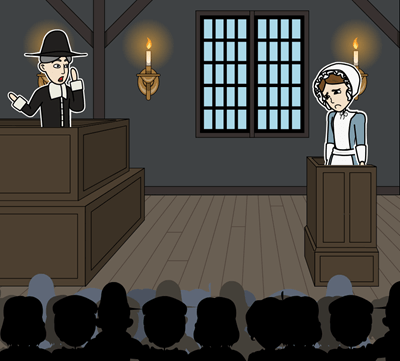The Crucible Themes Diagram

You can find this storyboard in the following articles and resources:

The Crucible by Arthur Miller
Lesson Plans by Rebecca Ray
The Crucible is a play with many allegorical references. Written during the 1950s but set in the 1600s, Arthur Miller used the Salem witch trials in Massachusetts to represent the figurative witch hunt for communists in the United States,commonly known as the 'Red Scare'. Using actual court manuscripts and primary documents, Miller brings to life the people of Salem, and the atrocities the occurred there, in this heart-wrenching play.

Increase Student Engagement, Enthusiasm, & Confidence
Lesson Plans by Kristy Littlehale
When my kids use Storyboard That, I see huge jumps in their ability to retain information, their engagement and enthusiasm, and their confidence.
'
Storyboard Description
Identify and describe the themes in The Crucible
Storyboard Text
- Slide: 1
- Reverend Hale’s appearance in Salem was not a precursor to the hysteria, fear, and paranoia. However, the scrutiny he placed everyone under enhanced the fearful feelings of the community.
- Slide: 2
- The real cause of the fear and paranoia comes from Abigail and the other young girls. To avoid punishment for dancing in the woods, drinking blood, and engaging in magic, they begin accusing everyone else. By being the accusers, not one is looking at them.
- Slide: 3
- One victim accused of with witchcraft is Giles Corey. Like Proctor, he tries to explain to the court that many of the accusations are motivated by a neighbor's greed. Inevitably, he is charged with witchcraft and dies by having large stones placed on top of him.
- Slide: 4
- Another member of the Salem community subjected to extreme prejudice is Rebecca Nurse. Although she is a model Christian, she is accused of witchcraft. With her incarceration, it makes Reverend Hale and the others look more closely at the fairness of the trials.
- Slide: 5
- Throughout the play, Reverend Parris seems more concerned with his reputation than with what is happening in his parish. He is repeatedly accused of being greedy, yet does nothing to disprove this notion.
- Slide: 6
- Conversely, Proctor's reputation is of little importance to him thourghout the play. Time and time again, he casts aside the rumors and lies of others. In the end, he martyrs himself. He would rather die than tell another lie, making him the last moral character.
Over 30 Million Storyboards Created
No Downloads, No Credit Card, and No Login Needed to Try!







